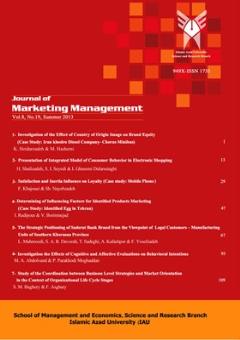-
-
List of Articles
-
Open Access Article
1 - Presenting the Customer Experience Management Model in Real Estate Marketing with a Mixed Approach
Reza kochakpour nesfi H. R. Saeednia Hamid Saeedi rahim mohtaram -
Open Access Article
2 - Presenting the model of smart tourism development strategies in Iran
leila Andervazh neda aslani kiumars Arya -
Open Access Article
3 - Providing a supply chain logistics dynamic model based on the Internet of Things with an emphasis on online marketing
mohammadali keramati mohammad hossein roshanzamir Azadeh Mehrani Safiyeh Mehrinejhad -
Open Access Article
4 - A Model of Electronic Entrepreneurship in Small and Medium Businesses with Grounded Theory Approach
seyed shahin hoseini Majid Fattahi Saeid Safarian Hamedani -
Open Access Article
5 - Identifying the Affecting Indicators, Components and Dimensions on Self-Discrepancy and Consumers Behavior of Luxury Goods
mehdi zakipour مجتبی امیری مجد sepideh najafi -
Open Access Article
6 - Designing a neural marketing model with a consumer behavior approach in the banking industry
Maryam Khezri yazdan shirmohammadi Mirarab Beigi Alireza -
Open Access Article
7 - Examining the moderating role of managers' and company's risk-taking in the relationship between economic policy uncertainty and innovation in companies
Fariba Ahmadi Amir Abadi Malihe Alifarri Zahra Honarmandi -
Open Access Article
8 - The Effect of Marketing Costs, Bank Concentration and Competitiveness on Banking Stability: The Case of Selected Oil Exporting Countries
hosein sharifi renani mohamad kamal mazhar al yaser ghasan taregh zaher almamori mostafa rajabi
-
The rights to this website are owned by the Raimag Press Management System.
Copyright © 2021-2025







